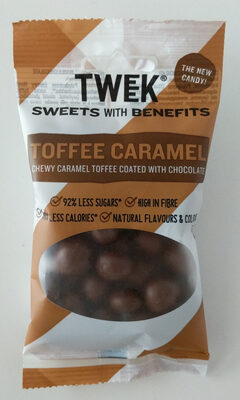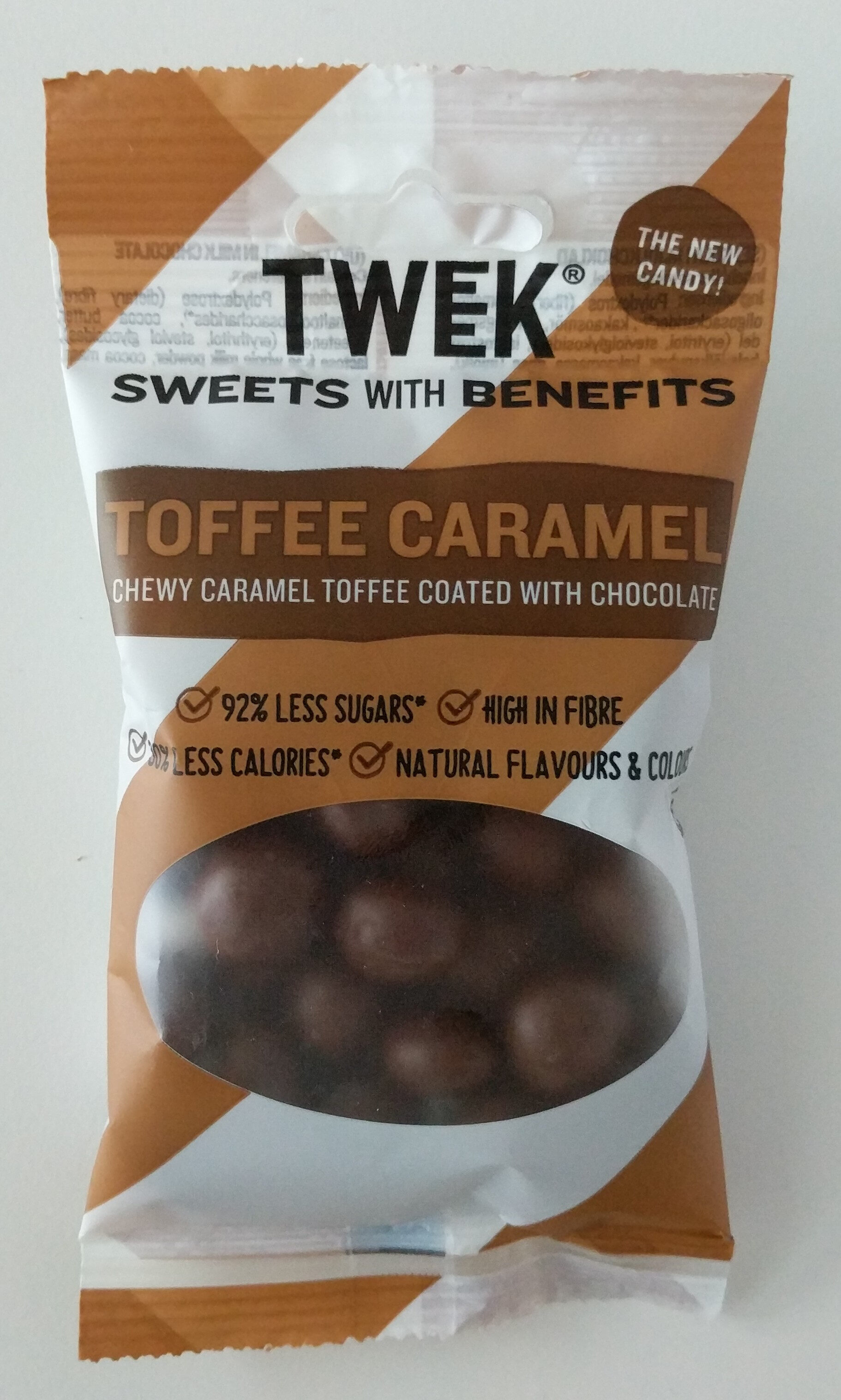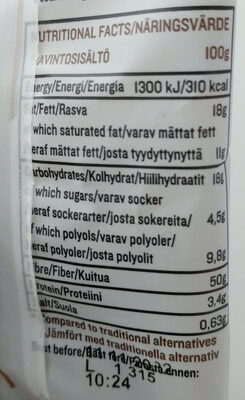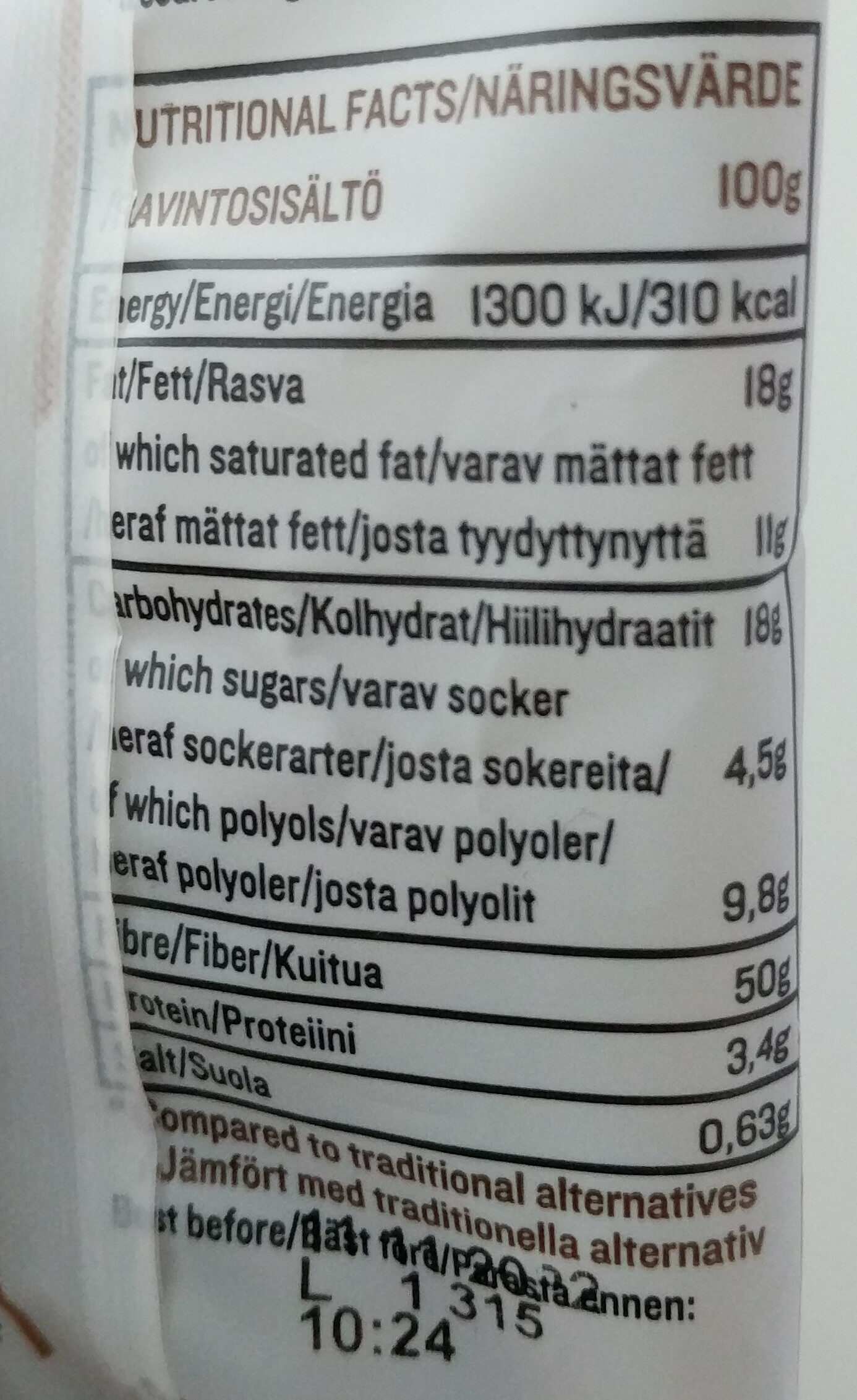Help us make food transparency the norm!
As a non-profit organization, we depend on your donations to continue informing consumers around the world about what they eat.
The food revolution starts with you!
Toffee caramel - Tweek - 65 g
Toffee caramel - Tweek - 65 g
This product page is not complete. You can help to complete it by editing it and adding more data from the photos we have, or by taking more photos using the app for Android or iPhone/iPad. Thank you!
×
Streckkod: 7350101604540 (EAN / EAN-13)
Kvantitet: 65 g
Förpackning: Plast
Varumärken: Tweek
Kategorier: Snacks, Söta snacks, en:Cocoa and its products, Konfekt, Chokladgodis, en:Bonbons
Etiketter, certifieringar, utmärkelser: en:No artificial colors
Länk till produktsidan på producentens officiella webbplats: https://en.tweeksweets.com/products/toff...
Butiker: K-Supermarket, COOP
Matching with your preferences
Hälsa
Ingredienser
-
21 ingredienser
Polydextros (fiber), isomaltooligosackarider, kakaosmör, sötningsmedel (erytritol, steviolglykosider), laktosfritt helmjölkspulver, kakaomassa, _ghee (mjölk)_, salt, naturliga aromer, emulgeringsmedel (E471, solroslecitin), ytbehandlingsmedel (gummi arabicum, shellack), vegetabilisk olja (kokos), surhetsreglerande medel (natriumbikarbonat)Allergener: Mjölk, fi:ghee, fi:gheeSpår: Gluten, Nötter, Jordnöt, Soja
Food processing
-
Ultra processed foods
Elements that indicate the product is in the 4 - Ultra bearbetade livsmedel och drycker group:
- Tillsats: E414 - Gummi arabicum
- Tillsats: E471 - Mono- och diglycerider av fettsyror
- Tillsats: E904 - Shellack
- Tillsats: E960 - Steviolglykosider
- Tillsats: E968 - Erytritol
- Ingrediens: Emulgeringsmedel
- Ingrediens: Arom
- Ingrediens: Ytbehandlingsmedel
- Ingrediens: Sötningsmedel
Food products are classified into 4 groups according to their degree of processing:
- Obearbetade eller minimalt bearbetade livsmedel
- Bearbetade kulinariska ingredienser
- Halvfabrikat
- Ultra processed foods
The determination of the group is based on the category of the product and on the ingredients it contains.
Tillsatser
-
E1200 - Polydextros
Polydextrose: Polydextrose is a synthetic polymer of glucose. It is a food ingredient classified as soluble fiber by the U.S. Food and Drug Administration -FDA- as well as Health Canada, as of April 2013. It is frequently used to increase the dietary fiber content of food, to replace sugar, and to reduce calories and fat content. It is a multi-purpose food ingredient synthesized from dextrose -glucose-, plus about 10 percent sorbitol and 1 percent citric acid. Its E number is E1200. The FDA approved it in 1981. It is 0.1 times as sweet as sugar.Källa: Wikipedia (Engelska)
-
E414 - Gummi arabicum
Gum arabic: Gum arabic, also known as acacia gum, arabic gum, gum acacia, acacia, Senegal gum and Indian gum, and by other names, is a natural gum consisting of the hardened sap of various species of the acacia tree. Originally, gum arabic was collected from Acacia nilotica which was called the "gum arabic tree"; in the present day, gum arabic is collected from acacia species, predominantly Acacia senegal and Vachellia -Acacia- seyal; the term "gum arabic" does not indicate a particular botanical source. In a few cases so‐called "gum arabic" may not even have been collected from Acacia species, but may originate from Combretum, Albizia or some other genus. Producers harvest the gum commercially from wild trees, mostly in Sudan -80%- and throughout the Sahel, from Senegal to Somalia—though it is historically cultivated in Arabia and West Asia. Gum arabic is a complex mixture of glycoproteins and polysaccharides. It is the original source of the sugars arabinose and ribose, both of which were first discovered and isolated from it, and are named after it. Gum arabic is soluble in water. It is edible, and used primarily in the food industry as a stabilizer, with EU E number E414. Gum arabic is a key ingredient in traditional lithography and is used in printing, paint production, glue, cosmetics and various industrial applications, including viscosity control in inks and in textile industries, though less expensive materials compete with it for many of these roles. While gum arabic is now produced throughout the African Sahel, it is still harvested and used in the Middle East.Källa: Wikipedia (Engelska)
-
E471 - Mono- och diglycerider av fettsyror
Mono- and diglycerides of fatty acids: Mono- and diglycerides of fatty acids -E471- refers to a food additive composed of diglycerides and monoglycerides which is used as an emulsifier. This mixture is also sometimes referred to as partial glycerides.Källa: Wikipedia (Engelska)
-
E500 - Natriumkarbonater
Sodium carbonate: Sodium carbonate, Na2CO3, -also known as washing soda, soda ash and soda crystals, and in the monohydrate form as crystal carbonate- is the water-soluble sodium salt of carbonic acid. It most commonly occurs as a crystalline decahydrate, which readily effloresces to form a white powder, the monohydrate. Pure sodium carbonate is a white, odorless powder that is hygroscopic -absorbs moisture from the air-. It has a strongly alkaline taste, and forms a moderately basic solution in water. Sodium carbonate is well known domestically for its everyday use as a water softener. Historically it was extracted from the ashes of plants growing in sodium-rich soils, such as vegetation from the Middle East, kelp from Scotland and seaweed from Spain. Because the ashes of these sodium-rich plants were noticeably different from ashes of timber -used to create potash-, they became known as "soda ash". It is synthetically produced in large quantities from salt -sodium chloride- and limestone by a method known as the Solvay process. The manufacture of glass is one of the most important uses of sodium carbonate. Sodium carbonate acts as a flux for silica, lowering the melting point of the mixture to something achievable without special materials. This "soda glass" is mildly water-soluble, so some calcium carbonate is added to the melt mixture to make the glass produced insoluble. This type of glass is known as soda lime glass: "soda" for the sodium carbonate and "lime" for the calcium carbonate. Soda lime glass has been the most common form of glass for centuries. Sodium carbonate is also used as a relatively strong base in various settings. For example, it is used as a pH regulator to maintain stable alkaline conditions necessary for the action of the majority of photographic film developing agents. It acts as an alkali because when dissolved in water, it dissociates into the weak acid: carbonic acid and the strong alkali: sodium hydroxide. This gives sodium carbonate in solution the ability to attack metals such as aluminium with the release of hydrogen gas.It is a common additive in swimming pools used to raise the pH which can be lowered by chlorine tablets and other additives which contain acids. In cooking, it is sometimes used in place of sodium hydroxide for lyeing, especially with German pretzels and lye rolls. These dishes are treated with a solution of an alkaline substance to change the pH of the surface of the food and improve browning. In taxidermy, sodium carbonate added to boiling water will remove flesh from the bones of animal carcasses for trophy mounting or educational display. In chemistry, it is often used as an electrolyte. Electrolytes are usually salt-based, and sodium carbonate acts as a very good conductor in the process of electrolysis. In addition, unlike chloride ions, which form chlorine gas, carbonate ions are not corrosive to the anodes. It is also used as a primary standard for acid-base titrations because it is solid and air-stable, making it easy to weigh accurately.Källa: Wikipedia (Engelska)
-
E500i - Natriumkarbonat
Sodium carbonate: Sodium carbonate, Na2CO3, -also known as washing soda, soda ash and soda crystals, and in the monohydrate form as crystal carbonate- is the water-soluble sodium salt of carbonic acid. It most commonly occurs as a crystalline decahydrate, which readily effloresces to form a white powder, the monohydrate. Pure sodium carbonate is a white, odorless powder that is hygroscopic -absorbs moisture from the air-. It has a strongly alkaline taste, and forms a moderately basic solution in water. Sodium carbonate is well known domestically for its everyday use as a water softener. Historically it was extracted from the ashes of plants growing in sodium-rich soils, such as vegetation from the Middle East, kelp from Scotland and seaweed from Spain. Because the ashes of these sodium-rich plants were noticeably different from ashes of timber -used to create potash-, they became known as "soda ash". It is synthetically produced in large quantities from salt -sodium chloride- and limestone by a method known as the Solvay process. The manufacture of glass is one of the most important uses of sodium carbonate. Sodium carbonate acts as a flux for silica, lowering the melting point of the mixture to something achievable without special materials. This "soda glass" is mildly water-soluble, so some calcium carbonate is added to the melt mixture to make the glass produced insoluble. This type of glass is known as soda lime glass: "soda" for the sodium carbonate and "lime" for the calcium carbonate. Soda lime glass has been the most common form of glass for centuries. Sodium carbonate is also used as a relatively strong base in various settings. For example, it is used as a pH regulator to maintain stable alkaline conditions necessary for the action of the majority of photographic film developing agents. It acts as an alkali because when dissolved in water, it dissociates into the weak acid: carbonic acid and the strong alkali: sodium hydroxide. This gives sodium carbonate in solution the ability to attack metals such as aluminium with the release of hydrogen gas.It is a common additive in swimming pools used to raise the pH which can be lowered by chlorine tablets and other additives which contain acids. In cooking, it is sometimes used in place of sodium hydroxide for lyeing, especially with German pretzels and lye rolls. These dishes are treated with a solution of an alkaline substance to change the pH of the surface of the food and improve browning. In taxidermy, sodium carbonate added to boiling water will remove flesh from the bones of animal carcasses for trophy mounting or educational display. In chemistry, it is often used as an electrolyte. Electrolytes are usually salt-based, and sodium carbonate acts as a very good conductor in the process of electrolysis. In addition, unlike chloride ions, which form chlorine gas, carbonate ions are not corrosive to the anodes. It is also used as a primary standard for acid-base titrations because it is solid and air-stable, making it easy to weigh accurately.Källa: Wikipedia (Engelska)
-
E904 - Shellack
Shellac: Shellac is a resin secreted by the female lac bug, on trees in the forests of India and Thailand. It is processed and sold as dry flakes -pictured- and dissolved in alcohol to make liquid shellac, which is used as a brush-on colorant, food glaze and wood finish. Shellac functions as a tough natural primer, sanding sealant, tannin-blocker, odour-blocker, stain, and high-gloss varnish. Shellac was once used in electrical applications as it possesses good insulation qualities and it seals out moisture. Phonograph and 78 rpm gramophone records were made of it until they were replaced by vinyl long-playing records from the 1950s onwards. From the time it replaced oil and wax finishes in the 19th century, shellac was one of the dominant wood finishes in the western world until it was largely replaced by nitrocellulose lacquer in the 1920s and 1930s.Källa: Wikipedia (Engelska)
-
E960 - Steviolglykosider
Steviol glycoside: Steviol glycosides are the chemical compounds responsible for the sweet taste of the leaves of the South American plant Stevia rebaudiana -Asteraceae- and the main ingredients -or precursors- of many sweeteners marketed under the generic name stevia and several trade names. They also occur in the related species Stevia phlebophylla -but in no other species of Stevia- and in the plant Rubus chingii -Rosaceae-.Steviol glycosides from Stevia rebaudiana have been reported to be between 30 and 320 times sweeter than sucrose, although there is some disagreement in the technical literature about these numbers. They are heat-stable, pH-stable, and do not ferment. Additionally, they do not induce a glycemic response when ingested, because humans can not metabolize stevia. This makes them attractive as natural sugar substitutes for diabetics and other people on carbohydrate-controlled diets. Steviol glycosides stimulate the insulin secretion through potentiation of the β-cell, preventing high blood glucose after a meal. The acceptable daily intake -ADI- for steviol glycosides, expressed as steviol equivalents, has been established to be 4 mg/kg body weight/day, and is based on no observed effects of a 100 fold higher dose in a rat study.Källa: Wikipedia (Engelska)
-
E968 - Erytritol
Erythritol: Erythritol --2R,3S--butane-1‚2,3‚4-tetrol- is a sugar alcohol -or polyol- that has been approved for use as a food additive in the United States and throughout much of the world. It was discovered in 1848 by Scottish chemist John Stenhouse. It occurs naturally in some fruit and fermented foods. At the industrial level, it is produced from glucose by fermentation with a yeast, Moniliella pollinis. Erythritol is 60–70% as sweet as sucrose -table sugar- yet it is almost noncaloric, does not affect blood sugar, does not cause tooth decay, and is partially absorbed by the body, excreted in urine and feces. Under U.S. Food and Drug Administration -FDA- labeling requirements, it has a caloric value of 0.2 kilocalories per gram -95% less than sugar and other carbohydrates-, though nutritional labeling varies from country to country. Some countries, such as Japan and the United States, label it as zero-calorie; the European Union labels it 0 kcal/g.Källa: Wikipedia (Engelska)
Ingrediensanalys
-
Kan innehålla palmolja
Ingredienser som kan innehålla palmolja: Ghee, E471
-
Icke-vegan
Non-vegan ingredients: Helmjölkspulver, Ghee, E904
-
Icke-vegetarisk
Non-vegetarian ingredients: E904
-
Details of the analysis of the ingredients
: Polydekstroosi (kuitu), isomalto-oligosakkaridit, kaakaovoi, makeutusaineet (erytritoli, stevioliglykosidit), _täysmaitojauhe_, kaakaomassa, _ghee_, suola, luontaiset aromit, emulgointiaine (e471), pintakäsittelyaineet (arabikumi, sellakka), kasviöljy (kookos), happamuudensäätöaine (natriumkarbonaatti)- Polydekstroosi -> en:e1200 - vegan: yes - vegetarian: yes - percent_min: 7.69230769230769 - percent_max: 100
- kuitu -> en:fiber - percent_min: 7.69230769230769 - percent_max: 100
- isomalto-oligosakkaridit -> en:isomalto-oligosaccharide - percent_min: 0 - percent_max: 50
- kaakaovoi -> en:cocoa-butter - vegan: yes - vegetarian: yes - ciqual_food_code: 16030 - percent_min: 0 - percent_max: 33.3333333333333
- makeutusaineet -> en:sweetener - percent_min: 0 - percent_max: 25
- erytritoli -> en:e968 - vegan: yes - vegetarian: yes - percent_min: 0 - percent_max: 25
- stevioliglykosidit -> en:e960 - vegan: yes - vegetarian: yes - percent_min: 0 - percent_max: 12.5
- _täysmaitojauhe_ -> en:whole-milk-powder - vegan: no - vegetarian: yes - ciqual_food_code: 19021 - percent_min: 0 - percent_max: 20
- kaakaomassa -> en:cocoa-paste - vegan: yes - vegetarian: yes - ciqual_proxy_food_code: 16030 - percent_min: 0 - percent_max: 16.6666666666667
- _ghee_ -> en:ghee - vegan: no - vegetarian: yes - from_palm_oil: maybe - ciqual_food_code: 16401 - percent_min: 0 - percent_max: 14.2857142857143
- suola -> en:salt - vegan: yes - vegetarian: yes - ciqual_food_code: 11058 - percent_min: 0 - percent_max: 0.63
- luontaiset aromit -> en:natural-flavouring - vegan: maybe - vegetarian: maybe - percent_min: 0 - percent_max: 0.63
- emulgointiaine -> en:emulsifier - percent_min: 0 - percent_max: 0.63
- e471 -> en:e471 - vegan: maybe - vegetarian: maybe - from_palm_oil: maybe - percent_min: 0 - percent_max: 0.63
- pintakäsittelyaineet -> en:glazing-agent - percent_min: 0 - percent_max: 0.63
- arabikumi -> en:e414 - vegan: yes - vegetarian: yes - percent_min: 0 - percent_max: 0.63
- sellakka -> en:e904 - vegan: no - vegetarian: no - percent_min: 0 - percent_max: 0.315
- kasviöljy -> en:vegetable-oil - vegan: yes - vegetarian: yes - from_palm_oil: maybe - percent_min: 0 - percent_max: 0.63
- kookos -> en:coconut - vegan: yes - vegetarian: yes - ciqual_proxy_food_code: 15006 - percent_min: 0 - percent_max: 0.63
- happamuudensäätöaine -> en:acidity-regulator - percent_min: 0 - percent_max: 0.63
- natriumkarbonaatti -> en:e500i - vegan: yes - vegetarian: yes - percent_min: 0 - percent_max: 0.63
- Polydekstroosi -> en:e1200 - vegan: yes - vegetarian: yes - percent_min: 7.69230769230769 - percent_max: 100
Näring
-
Average nutritional quality
⚠ ️Warning: the amount of fruits, vegetables and nuts is not specified on the label, it was estimated from the list of ingredients: 0This product is not considered a beverage for the calculation of the Nutri-Score.
Positiva poäng: 5
- Proteiner: 2 / 5 (värde: 3.4, avrundat värde: 3.4)
- Fiber: 5 / 5 (värde: 50, avrundat värde: 50)
- Frukt, grönsaker, nötter och raps- / valnöt- / olivoljor: 0 / 5 (värde: 0.0253846153846169, avrundat värde: 0)
Negativa poäng: 15
- Energi: 3 / 10 (värde: 1300, avrundat värde: 1300)
- Socker: 0 / 10 (värde: 4.5, avrundat värde: 4.5)
- Mättat fett: 10 / 10 (värde: 11, avrundat värde: 11)
- Natrium: 2 / 10 (värde: 252, avrundat värde: 252)
The points for proteins are not counted because the negative points are greater or equal to 11.
Näringsvärde: (15 - 5)
Nutri-Score:
-
Näringsvärden
-
Fett i måttlig kvantitet (18%)
What you need to know- A high consumption of fat, especially saturated fats, can raise cholesterol, which increases the risk of heart diseases.
Recommendation: Limit the consumption of fat and saturated fat- Choose products with lower fat and saturated fat content.
-
Mättat fett i hög kvantitet (11%)
What you need to know- A high consumption of fat, especially saturated fats, can raise cholesterol, which increases the risk of heart diseases.
Recommendation: Limit the consumption of fat and saturated fat- Choose products with lower fat and saturated fat content.
-
Sockerarter i låg kvantitet (4.5%)
What you need to know- A high consumption of sugar can cause weight gain and tooth decay. It also augments the risk of type 2 diabetes and cardio-vascular diseases.
Recommendation: Limit the consumption of sugar and sugary drinks- Sugary drinks (such as sodas, fruit beverages, and fruit juices and nectars) should be limited as much as possible (no more than 1 glass a day).
- Choose products with lower sugar content and reduce the consumption of products with added sugars.
-
Salt i måttlig kvantitet (0.63%)
What you need to know- A high consumption of salt (or sodium) can cause raised blood pressure, which can increase the risk of heart disease and stroke.
- Many people who have high blood pressure do not know it, as there are often no symptoms.
- Most people consume too much salt (on average 9 to 12 grams per day), around twice the recommended maximum level of intake.
Recommendation: Limit the consumption of salt and salted food- Reduce the quantity of salt used when cooking, and don't salt again at the table.
- Limit the consumption of salty snacks and choose products with lower salt content.
-
-
Näringsfakta
Näringsfakta Som såld
för 100 g / 100 mlSom såld
per portion (65g)Compared to: en:Bonbons Energi 1 300 kj
(310 kcal)845 kj
(202 kcal)−32 % Fett 18 g 11,7 g −15 % Mättat fett 11 g 7,15 g −11 % Kolhydrat 18 g 11,7 g −69 % Sockerarter 4,5 g 2,92 g −90 % Fiber 50 g 32,5 g +313 % Protein 3,4 g 2,21 g −28 % Salt 0,63 g 0,409 g +131 % Fruits‚ vegetables‚ nuts and rapeseed‚ walnut and olive oils (estimate from ingredients list analysis) 0,025 % 0,025 %
Miljö
-
Eco-score ej beräknad - Okänd miljöpåverkan
Vi kunde inte beräkna Eco-Score av denna produkt eftersom det saknas vissa data, kan du hjälpa till att slutföra det?Could you add a precise product category so that we can compute the Eco-Score? Lägg till en kategori
Förpackning
-
Packaging with a medium impact
-
Packaging parts
(Plast)
-
Packaging materials
Material % Packaging weight Packaging weight per 100 g of product Plast
-
Transportation
-
Origins of ingredients
Missing origins of ingredients information
⚠ ️ The origins of the ingredients of this product are not indicated.
If they are indicated on the packaging, you can modify the product sheet and add them.
If you are the manufacturer of this product, you can send us the information with our free platform for producers.Add the origins of ingredients for this product Add the origins of ingredients for this product
Report a problem
-
Incomplete or incorrect information?
Category, labels, ingredients, allergens, nutritional information, photos etc.
If the information does not match the information on the packaging, please complete or correct it. Open Food Facts is a collaborative database, and every contribution is useful for all.
Datakällor
Produkt tillagd den av mvainola
Senast ändrad produktsida på av drive55-user.
Produktsida också redigerad av moon-rabbit, openfoodfacts-contributors.











